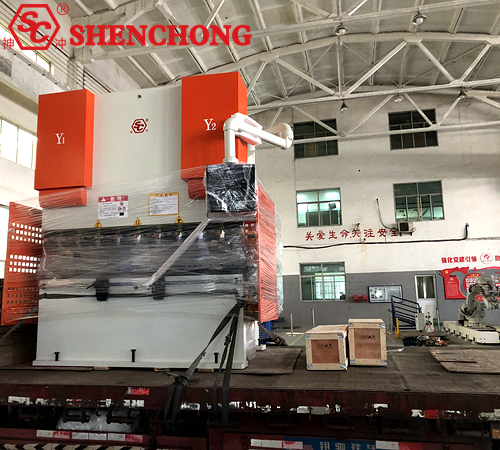
TBEA Electric Technology Co., Ltd. ordered the Shenchong CNC Press Brake WEK-160T 2000MM EL15T (4+1). The electrical technology company purchased the bending equipment mainly for the manufacture of various transformer accessories and mechanical equipment as well as the processing of metal castings and metal products.

- WEK CNC Hydraulic Press Brake
- 160Ton 2000mm
- EL15T
- 4+1 axis
In the manufacturing process of transformer accessories, metal bending process is widely used to manufacture housings, brackets, conductive parts, cooling parts and other accessories.
The following are the commonly used metal bending processes and their characteristics in the manufacturing of transformer accessories:
Features: Use CNC bending machines (such as hydraulic bending machines or servo electric bending machines) to bend metal sheets into V-shaped or U-shaped shapes.
Applicable to the manufacture of transformer housings, end covers, brackets and other structural parts.
Scope of application: Medium and thin plate processing, mostly made of steel, stainless steel, and aluminum alloy.
Process advantages: High precision, suitable for mass production. Adjustable bending angle and high flexibility.
Features: Complex geometric shapes such as box-shaped or polygonal shapes are formed through multiple bending.
Commonly used in the manufacture of transformer housings or complex internal brackets.
Scope of application: Thicker steel or aluminum plates, parts with complex structures.
Process advantages: Complex shapes can be achieved to meet special design requirements. High precision, suitable for cooperation with other processing technologies.
Features: Use a rolling machine to bend metal sheets into an arc or circle.
Applicable to the manufacture of cooling pipes, annular supports or some housing parts of transformers.
Scope of application: Cylindrical or arc-shaped workpieces, mostly used for aluminum, stainless steel, and copper materials.
Process advantages: Uniform bending without obvious creases. Large-sized workpieces can be processed.
Features: Pressing metal sheets to a specified shape with the help of molds and presses.
Commonly used for the processing of small accessories such as gaskets and connecting pieces in transformers.
Scope of application: Batch production of small parts, mostly used for copper and aluminum materials.
Process advantages: High efficiency, suitable for repetitive production. High precision and good surface quality.
Features: Instead of using specific molds, it relies on the bending machine for adjustment to achieve a variety of bending.
Applicable to the processing of accessories that require flexible angle adjustment.
Scope of application: Small batch production or trial production stage.
Process advantages: Low cost, suitable for non-standard parts and small batch production. Strong flexibility, suitable for a variety of materials.
Features: Bending the edge of the plate to form a bulge or flange.
Mostly used for the connection parts of the transformer housing to enhance the structural strength.
Scope of application: Processing of steel and aluminum plates, especially parts that need to be connected.
Process advantages: Improve edge rigidity for easy connection or assembly. Good surface quality and more solid structure.
Features: Fix the metal plate and apply tension, and bend it with the mold at the same time.
Used to manufacture large arc supports or guide plates for transformers.
Scope of application: Thicker large plates, mostly aluminum or stainless steel.
Process advantages: Uniform bending without rebound. Large-sized workpieces can be processed.
Features: By adding rib design during the bending process, the strength of the plate is enhanced.
Commonly used for parts that require load-bearing strength such as transformer housings and bases.
Scope of application: Processing of steel and stainless steel plates.
Process advantages: Enhance structural strength and durability. Reduce overall weight.
Features: Using a specific forming die, complex structural parts can be processed through one-time forming.
Applied to accessories with complex shapes such as conductive parts (such as copper bars), cooling pipe supports, etc.
Scope of application: Processing of copper, aluminum and other conductive metals.
Process advantages: One-time processing and forming, high efficiency. Good product consistency, suitable for mass production.
Features: Using advanced CNC press brake bending machines to achieve high-precision bending. The bending angle, pressure and sequence can be automatically adjusted.
Scope of application: Diversified and complex transformer accessories.
Process advantages: High degree of automation, precision control within ±0.1mm. Programmed operation, suitable for multi-batch production.

Select suitable metal materials according to the functions of transformer accessories, such as steel plates for shells and copper or aluminum for conductive parts.
Ensure material quality and avoid surface oxidation or unevenness.
The bending radius should meet the minimum bending radius requirements of the material to avoid cracking or failure.
For materials with springback (such as high-strength steel plates), the bending angle needs to be adjusted or subsequent correction procedures need to be added.
Ensure that the molds are matched and maintained regularly to avoid affecting precision due to mold wear.
Deburring, derusting, passivating or coating the bent parts to ensure product durability and electrical performance.
Use measuring tools or automatic inspection equipment to detect the size and angle of the bent parts to ensure that they meet the design requirements.
In the manufacturing process of transformer accessories, the choice of metal bending process depends on the shape, size and functional requirements of the parts. Reasonable selection and optimization of the bending process can improve production efficiency, ensure product quality, and meet the needs of different accessories.